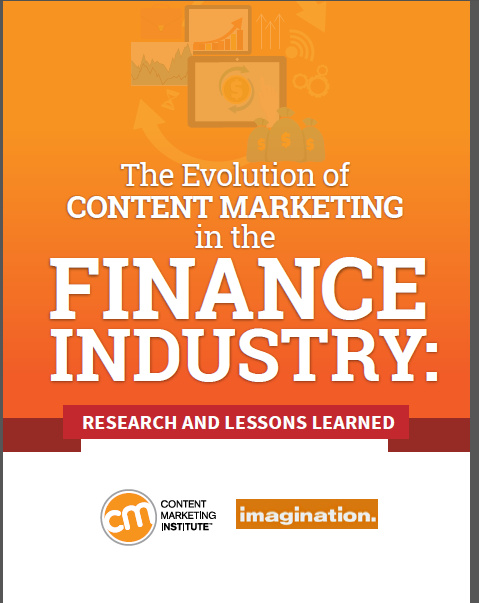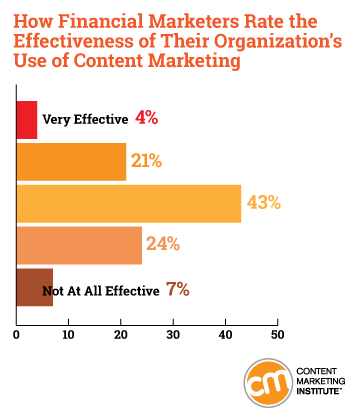The challenges for marketers in the financial industry are similar to those being experienced in other industries: The marketplace is changing, and customers are no longer responding to one-size-fits-all approaches. But this industry has its own unique considerations: Financial marketers operate in a heavily regulated industry and their customers can no longer be categorized as being interested in only business finance or only personal finance.
In its latest white paper, the Content Marketing Institute examines the finance sector – sharing research about how these marketers use content marketing and highlighting examples, tips, and takeaways from those who are finding success.
You can read all the discoveries in the white paper, The Evolution of Content Marketing in the Finance Industry: Research and Lessons Learned sponsored by Imagination.
How do you size up?
Let’s start with some high-level research. Among the findings in CMI’s fifth annual content marketing survey:
- 78% of marketers in the financial industry report using content marketing.
- Of those who use content marketing, 25% consider themselves to be effective.
- Brand awareness, engagement, and lead generation are their most important goals for content marketing.
- Unlike marketers in other verticals, financial marketers are more likely to prioritize customer retention/loyalty over sales.
Want more research? Learn the one trend observed among those marketers who are more effective, how groups are organizing themselves, top challenges, and more in the white paper.
While the research is helpful in assessing how your content marketing program compares to others in the industry, we also want to share tangible examples so you can see how your counterparts are operationalizing their content marketing to provide helpful tips and takeaways. Here are three examples that offer ideas on how financial services firms are using content marketing and what you can learn.
Become an unexpected solution
Fifth Third Bank translated a jaw-dropping statistic into an entire platform of content.
When it learned half of recent college graduates don’t have full-time jobs, the bank posed a question to its audience: What can Fifth Third do to help this next generation?
Then, it ponied up $1 million in free job-coaching services and asked job seekers to post on Twitter with an explanation of why they deserve the money. Fifth Third selects 80 winners a day, and participants can post one entry tweet a day. Using the hashtags #BrandofYou and #53Enter, entrants are creating a conversation (originating on Twitter and shared on the Fifth Third microsite), and in turn, the bank is receiving interesting insights into the minds of the coveted millennial audience.
But it’s not just a contest. Fifth Third’s Brand of You microsite also shares inspiring stories of recent college graduates and offers practical guidance, like tips for taking a professional headshot or templates for creating a resume.
TIPS:
- Monitor studies and trends that relate to your target audiences to identify ways to create timely and relevant content. If you can help solve your audience’s problems, you are well positioned as a trusted resource.
- Marry paid advertising campaigns (Fifth Third has invested significantly in traditional advertising, including TV ads, to promote its contest) with content-focused platforms. By driving traffic to your home base, you have an opportunity to provide additional information that can exceed the visitor’s expectations.
Adapt to changing marketplace
Over 15 years ago, Wells Fargo created a print magazine for the small-business audience. The magazine was well received because its content covered topics relevant to the typical small-business owner, explains Doug Case, small-business segment manager at Wells Fargo, a client of Imagination.
However, eight years ago, the print version started losing traction with its audience so Wells Fargo created a digital platform to bring some of the content from its magazine to online readers.
Five years later, the online portal was no longer sufficient, and the company wanted to add dimension to its value proposition as America’s No. 1 small-business lender. “We needed to frame our messages in a way that would resonate better with today’s small-business owners in America,” Case says.
That idea was the seed. The Wells Fargo team dove deeper to understand the content interest levels of small-business owners, their capacity to consume content, and the channels on which they wanted the content delivered.
Wells Fargo also examined its content competitors — which meant looking beyond its finance industry competitors to all companies that serve the small–business community. Wells Fargo went beyond the surface topics that should attract business owners and explored what would attract business owners. Thus, the Wells Fargo Works for Small Business initiative was born.
As Case explains, “We wanted to create a site that was easy to use … We added an immense amount of new content reorganized around the important stages of a small business. We lean toward shorter content such as topical videos, articles, and infographics.”
TIPS:
- Don’t be afraid to shift your content marketing strategy to stay in step with your evolving business and your evolving customers.
- Think beyond what topics your customers are interested in – look at how, where, when, and why they use content – to create a fully informed strategy with a greater opportunity for success.
Make it fun
- Rowe Price uses a fun, illustrated video-storybook telling of the couple who discovers how much college could cost for their child. Now, most parents already recognize the high cost of college, but the video offers a light way to remind them that having a 529 plan is an excellent way to save and reduce that college-funding stress.
The video, which is hosted on the company’s YouTube channel, is just one component of the College Savings Chill Out microsite, which also allows visitors to order a print version of the story and offers six lessons to help them get started saving for college.
TIPS:
- Tell stories in ways that people can relate to and in which they recognize themselves personally – they want to know you understand them and their struggles.
- Have fun — the topic you choose may be serious, but your content format and tone don’t have to be. Look for ways to inject humor into your content or make the conversation a little less formal.
Want to learn more about the research, lessons, examples, and takeaways? Read the white paper, The Evolution of Content Marketing in the Finance Industry: Research and Lessons Learned, sponsored by Imagination.
Cover image by Joseph Kalinowski/Content Marketing Institute







